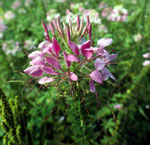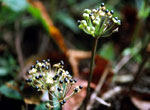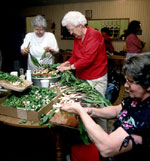Biodiversity, a Seasonal Round, and National Forest Policy
Even in what residents perceive to be a deteriorated state, the comparative vitality of this forest is striking. Following his first visit to the coves on Coal River, plant pathologist David Houston of the USFS Northeastern experiments station commented, "I marvelled at the lushness and species diversity and the magnitude of the trees."10 Around that lushness, diversity, and magnitude, residents of the Coal River Valley have for generations created culture. The fertile coves that once replenished the Eastern deciduous forests teem with plants, wildlife, and structures that are not merely economic resources, but templates for patterning life. "Plant corn when the oak leaves are as big as a squirrel's ear," said John Flynn to Dennis Christian of Dry Creek, a former schoolmate. Christian returned, "Plant corn when the dogwood's in full bloom. That's an old saying."
A seasonal round that synchronizes gardening, hunting, and the marketplace with the forest's bounty begins each year in mid-March with a trip to the ramp patch. Ramps, wild cousins of garlic and the first of the wild foods, are featured at spring feasts throughout the Southern mountains, together with boisterous jokes about the odor ramps bestow on their loyal consumers. "Get that hot sausage," said Ben Burnside, "have them ramps ready, scramble in the egg, three slices of cheese, boy, I'll tell you, ain't nothing better."
In every season the forest supports the round, with spring greens (poke, dock, "crow's feet," "woolly britches," cresses, "Shawnee lettuce," dandelions, wild mustard and a number of others), berries ("sarvice" berries, wineberries, blackberries, raspberries, "sheep tits," huckleberries, and mulberries), and the nuts and fruits of fall (hazelnuts, acorns, chinquapins, beechnuts, butternut, walnut, persimmons, paw-paws, and bitternut, pignut, and mockernut hickory). There are mushrooms, the spring morels called "molly moochers," the red ones of autumn that Elsie Rich, of Jarrold's Valley, called "bull's tongue," and the "little white ones" that remind Mary Allen of choice seafood. "You cut them in two, they're kind of like a scallop," she said, "and roll them in flour and fry them, they're good."
Hunting and digging ginseng, the most famous of the wild cash crops, is an abiding passion for a number of men on Coal River. "I'd as soon ginseng as eat when I'm hungry," said Dennis Dickens, eighty-five. "Every spare minute I had was spent a-ginsenging." And, of course, each season has its quarry, and each quarry its aficionados, for whom gathering wild products provides opportunities to observe this year's distribution of preferred game, whether deer, bear, turkey, grouse, rabbit, raccoon, groundhog, squirrel, or rattlesnakes.
Participation in this round informs local timbering practices. Bob Daniel, of Dry Creek, owner of Appalachian Hardwoods, spoke of the importance of den trees. "Some people call beeches 'wolf trees' because they gobble up all the nutrients. [But] I like to leave four or five, if they're not too close together, for game."
Such talk may seem at first blush irrelevant to national goals of forest preservation and management, since none of the forested land there falls within a National Forest. Yet the National Forest Management Act of 1976 (P.L. 94-588) charges the U.S. Forest Service to maintain for the nation "a natural resource conservation posture that will meet the requirements of our people in perpetuity." On Coal River, descriptions of a forest as part of a living, working landscape spell out those requirements, modeling a diversified system of mixed-age stands that is a dynamic, healthy, and human environment.
Tied to a diminishing seasonal round, memories of residents highlight the importance of old-growth in a biocultural system. Traditional practices like honey harvesting, squirrel hunting, and tapping maple syrup depended on the presence of mature trees. "When I was young," said Kenneth Pettry, "I hunted a lot. You couldn't go a hundred feet in the mountains until you found walnuts, beeches. You don't see it no more. Hickory was thick then. You could go into a grove of hickories and had to watch where you stepped or you'd fall in the nuts. It ain't that way now. Dad showed me and my two older brothers how to tap sugar maples. Show me a sugar maple today you could get a pint out of. The walnuts that stood in our barnyard was six foot through."
In Sundial, Wesley Scarbrough, twenty-two, abandoned squirrel hunting five years ago. "There used to be stands of hickories all over," he observed, "and it was more of a challenge. But now you go and there's very few hickories where they can feed, and you know that they're all going to be around that one tree, and there ain't no sport."
"And I'll tell you another thing," said Robert Allen, sixty-seven. "Wild bees. There used to be a lot of them around here, and now they're dying out. The wild bees would be in the older trees. The younger trees wouldn't be big enough." Lining bees with the aid of a sweet lure, one could follow them to their hive, exploiting the terrain of the coves to keep the bees in sight. "I'll tell you the best way to beeline," said Dave Bailey, fifty-eight, of Stickney. "Get in the holler where the sun comes up and comes down in. Get over on the other bank and set there and you can watch them in that sun." Breaking into the wild stash, one could track the course of a blooming season in a mixed mesophytic hive. "The linden is more mild," said Robert Allen, "It's almost clear. Locust honey is a little stronger honey, and it's amber colored. Then you get the poplar, it's almost black and it's real strong."

![]()
![]() [Detail] Spider flowers (cleome) in Ben Burnside's garden. Terry Eiler. 1997/09. Library of Congress American Folklife Center.
[Detail] Spider flowers (cleome) in Ben Burnside's garden. Terry Eiler. 1997/09. Library of Congress American Folklife Center.

![]()
![]() [Detail] Ramps gone to seed. Woody Boggs. 1998. Library of Congress American Folklife Center.
[Detail] Ramps gone to seed. Woody Boggs. 1998. Library of Congress American Folklife Center.

![]()
![]() Wild geraniums behind the Jarrell home in Dry Creek. Lyntha Scott Eiler. 1998/05/14. Library of Congress American Folklife Center.
Wild geraniums behind the Jarrell home in Dry Creek. Lyntha Scott Eiler. 1998/05/14. Library of Congress American Folklife Center.

![]()
![]() [Detail] Mabel Brown in the ramp patch behind her home. Lyntha Scott Eiler. 1997/04/20. Library of Congress American Folklife Center.
[Detail] Mabel Brown in the ramp patch behind her home. Lyntha Scott Eiler. 1997/04/20. Library of Congress American Folklife Center.

![]()
![]() [Detail] Mabel Brown, Jenny Bonds, and Peggy Gilfillen, cleaning ramps in the Ramp House at the head of Drew's Creek. Terry Eiler. Library of Congress American Folklife Center.
[Detail] Mabel Brown, Jenny Bonds, and Peggy Gilfillen, cleaning ramps in the Ramp House at the head of Drew's Creek. Terry Eiler. Library of Congress American Folklife Center.

![]()
![]() [Detail] Glenna Bailey in her kitchen making deer soup. Lyntha Scott Eiler. 1996/05/24. Library of Congress American Folklife Center.
[Detail] Glenna Bailey in her kitchen making deer soup. Lyntha Scott Eiler. 1996/05/24. Library of Congress American Folklife Center.
